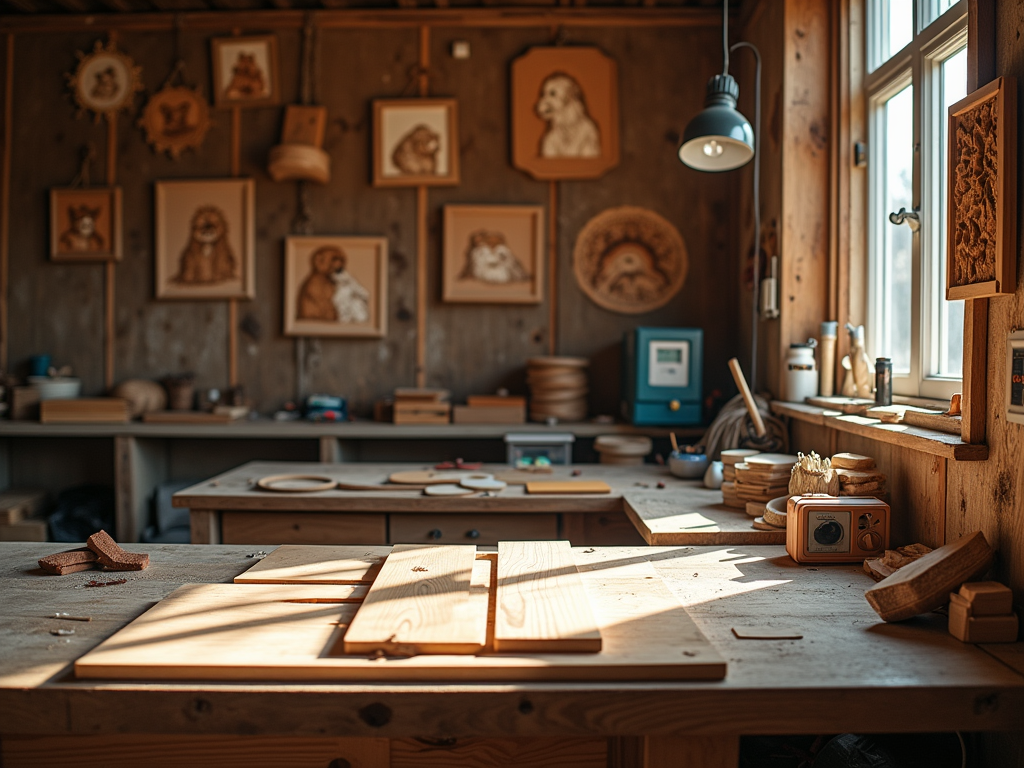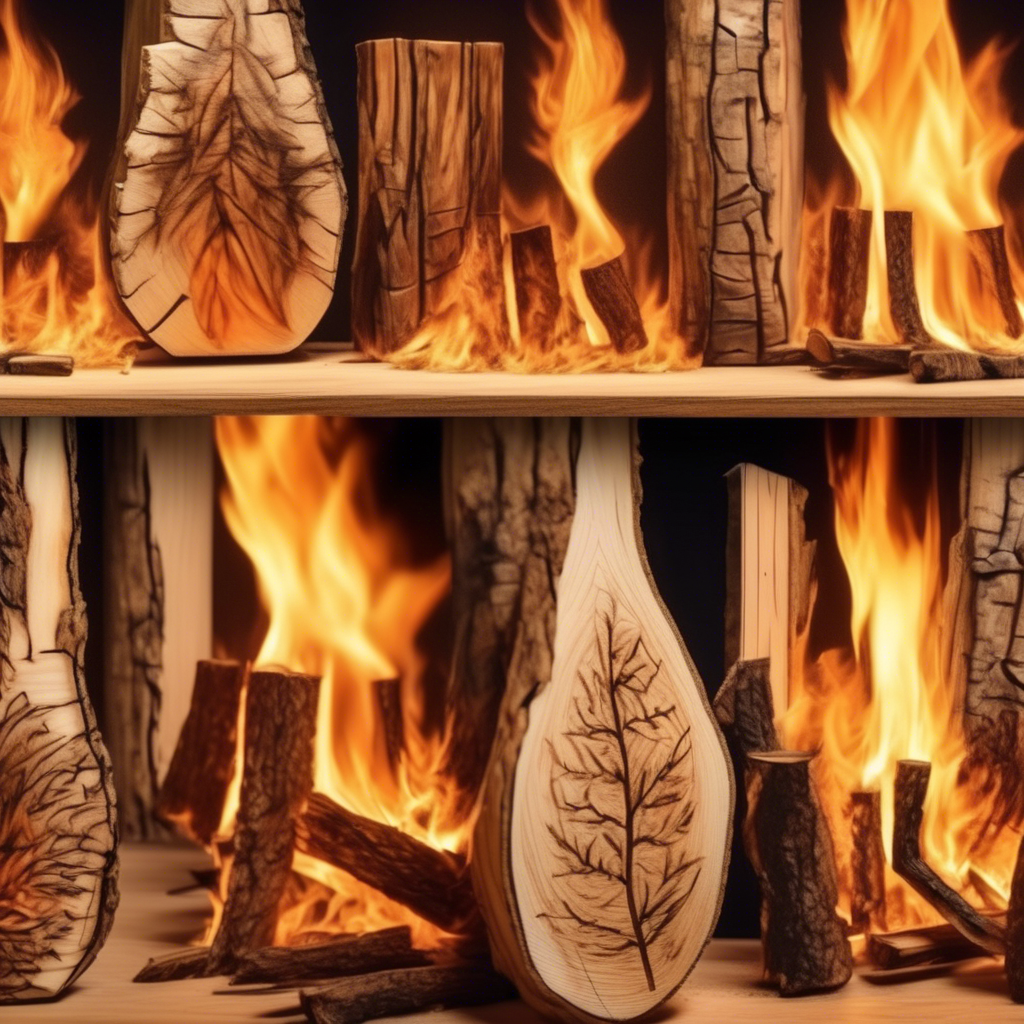I create stunning wood-burning artwork through precise temperature control, optimal tool selection, and refined techniques. Different burning tips and methods combine to produce professional results filled with depth and natural dimension.
Key Takeaways
- Temperature control is crucial, with lower settings (2-4) for light shading and higher settings (8-10) for bold details
- Wire-nib burners offer superior control compared to solid-point tools for detailed work
- Speed and consistent pressure are essential for achieving smooth, professional burns
- Layering multiple light passes creates more natural-looking results than rushing to dark burns
- Proper wood selection and surface preparation significantly impact the final results
Essential Tools and Temperature Control for Wood Burning
I’ve found that mastering temperature control is key to achieving professional wood burning results. A quality variable temperature wood burning tool lets me adjust settings from 1-10, giving complete control over burn intensity.
Understanding Temperature Settings and Tips
Temperature control plays a vital role in creating texture and shading effects. I recommend starting with lower settings (2-4) for light shading work, then moving to medium settings (5-7) for deeper tones. The highest settings (8-10) work best for bold, dark details and creating dramatic portraits.
Wire-nib burners offer quick temperature adjustments compared to solid-point tools, making them perfect for detailed work. Here are the essential tips I use for different techniques:
- Universal/Writing Tip: Perfect for clean outlines and basic strokes
- Spoon Shader: Creates smooth, even gradients for layered shading effects
- Ball Tip: Excellent for stippling and creating textured patterns
- Knife Tip: Delivers sharp, precise lines for detailed work
- Spear Shader: Ideal for blending and creating realistic shadows
Each tip serves a specific purpose in my wood-burning toolkit. I switch between them depending on the effect I want to achieve, often using multiple tips in a single project to create depth and variety in my burns.
I’ve learned that solid-point burners, while limited to a single temperature, can still produce stunning results with practice. They’re particularly good for consistent line work and simple designs. However, for detailed shading and texture work, I prefer variable temperature tools for their flexibility and control.
Mastering Shading Through Speed and Pressure
Speed and Temperature Control
Creating lifelike shading in wood burning requires a delicate balance of speed and temperature. I’ve found that mastering pyrography shading techniques starts with understanding how these elements work together. Moving my burning tool quickly across the wood surface produces lighter marks, while slower movements create deeper, darker burns.
Temperature control plays an equally crucial role in achieving the perfect shade. Before starting any project, I always test different heat settings on scrap wood from the same piece I’ll be working with. This practice helps me dial in the right temperature and gives me a clear picture of how the wood will respond to various burning intensities.
Pressure and Stroke Technique
Light, consistent pressure is key when working with wire-nib burners. I’ve learned that letting the heat do the work produces much better results than forcing the tool into the wood. Creating smooth shading transitions comes from varying my stroke speed while maintaining gentle pressure.
To achieve different shading effects, I focus on these essential techniques:
- Start with light, quick strokes to establish base tones
- Gradually slow down the movement for darker areas
- Keep the pressure gentle and consistent throughout
- Layer strokes in the same direction for smooth gradients
- Allow each layer to cool before adding more depth
Building up layers of shading takes patience, but rushing the process can damage both the wood and the burning tool. I’ve discovered that successful shading isn’t about pressing harder – it’s about finding the sweet spot between movement speed and heat setting. This approach helps me maintain precise control while creating rich, varied tones in my work.
The combination of proper speed, heat, and pressure creates depth that brings wood-burned pieces to life. By practicing these techniques on test pieces, I can confidently execute beautiful wood-burning designs with consistent, professional-looking results.

Creating Depth Through Layering and Texture
Building Layers for Realistic Effects
I’ve found that mastering wood-burning depth starts with understanding how to build layers properly. Starting with lighter tones and steadily progressing to darker ones gives me complete control over the final outcome. The key is patience – rushing straight to dark burns rarely produces natural-looking results. Instead, layering multiple light passes in pyrography creates rich, dimensional pieces that catch the eye.
Essential Texture Techniques
Through years of practice, I’ve developed a toolkit of reliable texture techniques that consistently deliver stunning results. Creating authentic textures in wood burning relies on matching the right approach to each element I’m trying to recreate.
Here are my go-to techniques for specific textures:
- Stippling: I use tight clusters of dots for skin pores, sand, or stone surfaces
- Cross-hatching: Perfect for fabric textures and structured shadows
- Scribbling: Creates soft, random textures ideal for clouds or fur
- Directional strokes: I follow wood grain patterns for natural flow
- Feathering: Light, quick strokes work great for fur and feathers
- Circular motions: Excellent for creating water ripples and leaf textures
Working with the wood’s natural grain is critical for achieving seamless results. I always check the grain direction before starting and plan my shading patterns accordingly. This prevents unwanted lines or breaks in the texture that might distract from the overall piece.
For particularly complex textures like animal fur or human hair, I combine multiple techniques. I might start with broad directional strokes to establish the main flow, then add stippling for depth, and finish with fine cross-hatching to create shine points. Creating realistic portraits through wood burning becomes much more manageable when breaking down textures this way.
Temperature control plays a vital role in texture creation. I adjust my pyrography tool’s heat based on the effect I want – cooler temperatures for subtle details and warmer settings for bold, dark accents. Selecting the right pyrography tip is equally important, as each tip creates distinct marks and textures.
Mastering essential wood-burning techniques takes practice, but the results are worth the effort. I’ve learned that overlapping strokes create smoother transitions between tones, while varying pressure helps achieve different texture depths. By combining these methods thoughtfully, I can recreate almost any texture – from smooth river stones to rough tree bark.

Selecting and Preparing Your Wood
I’ve found that choosing the right wood is essential for creating stunning pyrography artwork. Basswood stands out as my top pick for newcomers since its soft, light-colored surface takes burning beautifully and lets you focus on developing your wood burning techniques without fighting the material.
Best Woods for Pyrography
Here’s my tested ranking of woods for pyrography, based on their burning characteristics:
- Basswood – Offers minimal grain interference and consistent burning quality, perfect for practicing realistic shading techniques
- Poplar – Provides a slightly harder surface than basswood while maintaining good burn consistency
- Birch – Readily available and burns well, though plywood versions need extra attention to prevent layer separation
- Maple – Requires higher temperatures but delivers sharp, clean lines for detailed work
- Pine – Can be challenging due to its prominent grain and resin content, which might cause uneven burning
Before starting any project, I always prepare my wood surface carefully. Starting with 150-grit sandpaper, I work my way up through 180 and finish with 220-grit or finer. This progressive sanding creates an ideal surface for achieving smooth shading and texturing.
The extra time spent on preparation pays off in the final results. A properly sanded surface allows for better heat distribution and more consistent burns, which is crucial when I’m working on detailed pieces like wood-burned portraits. I’ve learned that skipping proper surface preparation can lead to patchy burns and uneven layering effects.
For the best burning control, I make sure my wood is completely dry and stored in a climate-controlled environment. This prevents any moisture-related issues that could affect the burning process. When selecting wood pieces, I check for any knots, splits, or imperfections that might interfere with my design, especially when I’m planning to use different burning tips for various effects.

Final Details and Finishing Methods
I’ve found that subtle outlines make a huge difference in achieving professional-looking pyrography. Rather than creating harsh, defined lines, I blend the outlines into the shading, which creates a more natural transition between elements in your piece. This technique pairs perfectly with realistic shading methods to produce depth and dimension.
Highlighting and Protection Techniques
Strategic highlighting can transform an average burning into something extraordinary. I’ve learned that leaving specific areas unburned creates natural highlights that catch the eye. If I need to add highlights after burning, I carefully scrape or lightly sand the surface to restore lighter areas. This method works particularly well when layering pyrography techniques for added dimension.
Here are my tested finishing options to protect and enhance your work:
- Clear acrylic sprays (available in matte, satin, or gloss finishes)
- Water-based varnishes for a crystal-clear finish
- Oil-based varnishes for deep wood penetration
- Natural oils like tung oil or Danish oil for a rich appearance
- UV-resistant sealants to prevent fading
Before applying any finish to your masterpiece, I always recommend testing it on a scrap piece of burned wood first. This extra step helps you spot any potential issues with color changes or texture effects. Each finishing product interacts differently with burned wood, and some can darken or alter the contrast of your wood-burned artwork.
The choice between finishes often depends on your piece’s intended use and display location. For outdoor pieces or those in sunny spots, UV-resistant sealants are essential. Indoor decorative pieces might benefit more from the warm enhancement that natural oils provide. If you’re looking to maintain the natural wood appearance while adding protection, a matte finish clear coat strikes an excellent balance.

Sources:
Wood Burn University
Pyrography Magazine
Sue Walters Pyrography Workbook
The Complete Book of Pyrography – Stephen Poole
Online Pyrography Communities & Forums (e.g., Sawmill Creek, dedicated Facebook Groups – general reference)

